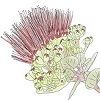9.3: Angiosperms families
- Page ID
- 59252
Families are large groups within the Kingdom Plantae (plants) that share certain characteristics and have a common ancestor. Originally, these families were defined based on their morphological characteristics (shape). Today, we can use additional sources of data, like DNA to group plants into families and to more accurately reconstruct the evolutionary relationships of plants. The visible characteristics of plants (morphology) are still very useful for plant identification and can have practical uses. For example, some diseases may affect members of a specific family, some families are known to produce poisonous compounds, or some families may have specific germination requirements, like the case of Orchidaceae. The more you learn about plant families and their characteristics, the easier it is to identify plants. You start to notice that a plant you know may have similar characteristics to other plants.
Here we will cover just a few examples of plant families in the monocot and eudicot groups (Figure \(\PageIndex{1}\)). These families have been selected due to their diversity of species, cultural, ecological, and economic importance. Of course, we encourage you to learn about other plant families; the ones listed here are just to get you started.
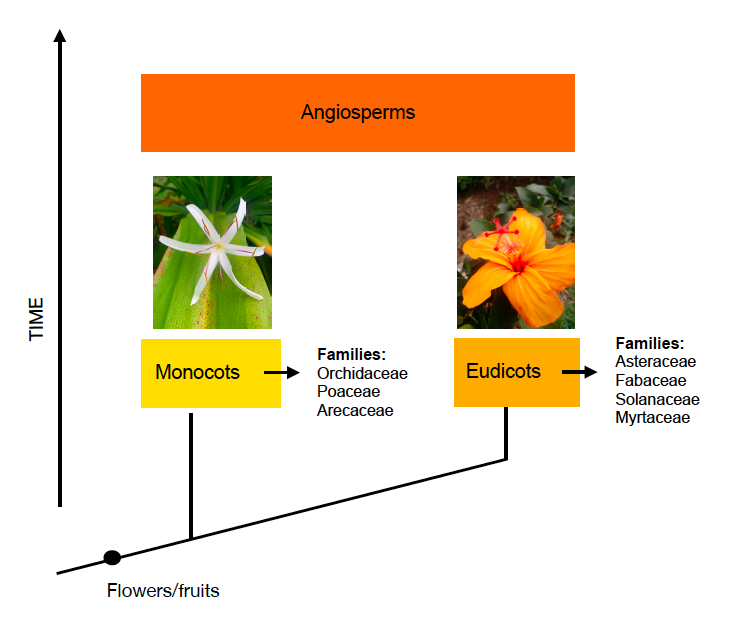
Examples of Monocot families
Orchidaceae
The Orchidaceae is the largest plant family with approximately 28,000 species (Christenhusz and Byng, 2016). All species are herbs, but they can either be terrestrial or epiphytic. Terrestrial orchid species in temperate zones spend part of their lifecycle under the ground and at a certain time of the year the leaves may grow above ground and they may bloom and form fruits. The cycle may continue with the plant dropping its leaves and going dormant for a period of the year. In the tropics, terrestrial species may grow year-round. Epiphytic orchid species are found in tropical and subtropical environments. They use trees for support without damaging them. This is an important strategy when growing in a forest since little sunlight gets to the forest floor. These plants can grow high up in the canopy of trees where they benefit from more sunlight and access to pollinators.
Orchid species are highly diverse, presenting different flower shapes and colors. Researchers attribute the diversity of species in the Orchidaceae to co-evolution with pollinators and fungi. Some orchid species offer nectar as a reward, while others mimic insect shapes or pheromones that trick insects into believing the flowers are their mating partner. Many species in this family rely on specific animals for pollination. For example, vanilla (Vanilla planifolia), which is native to Mexico, is pollinated by a native species of bee. When the plant is grown outside of its natural range, like in Hawai‘i, hand pollination is required for plants to produce fruit capsules (Figure \(\PageIndex{2}\)). The fruit of vanilla is the part of the plant used to make vanilla extract.
Hawai‘i has three native orchid species, all found in high elevations. All of them are terrestrial and likely arrived here by air currents. Non-native orchids are very popular in Hawai‘i and many growers focus on propagating hybrids for the horticultural market.
Common Characteristics
Habit: Either epiphytic or terrestrial herbs.
Flower: Instead of having petals and sepals, orchids have six tepals including a modified lip. The anthers are grouped into a structure called the pollinia.
Fruits and Seeds: The fruit in this family is a capsule. Seeds are very small and do not have food reserves. Instead, they rely on fungi to germinate (mycorrhizal association). When the seed gets dispersed from the capsule, it needs to land in a location with a specific fungus present. This fungus then inserts its mycelium into the seed and provides it with nutrients. The seed is completely dependent on the fungus until it can photosynthesize. Figure 9 shows orchid seeds that are germinating in association with mycorrhizae.
Leaves: Leaves are often simple with parallel veins (i.e. typical monocot leaf characteristics).
Stems: All species have herbaceous stems. Stems can either be monopodial (grow from a single shoot like in vanilla; Figure \(\PageIndex{2}\)) or sympodial (grow from new shoots emerging from a rhizome base). Many species have a specialized stem called a pseudobulb which can store water and nutrients.
Other: Epiphytic orchids have velamen (specialized epidermis) on their roots which protects the exposed roots from ultraviolet light damage while allowing the root to absorb nutrients and water directly from the surrounding environment.

Poaceae
The Poaceae is the fifth largest plant family with 12,000 species (Christenhusz and Byng, 2016), and includes some very important species for human consumption: corn, rice, wheat, barley, and millet, as well as for animal feed (corn), construction materials (bamboo and grasses for thatching), and biofuels (ethanol made from corn and sugarcane). Several species of grasses were domesticated thousands of years ago and today they are known as cereal crops. For example, corn was domesticated in central Mexico around 10,000 years ago (Tian et al., 2020). The ancestor of corn (wild relative) is teosinte, a large grass. Since its domestication, corn has been taken all over the globe and it is now one of the most important crops worldwide.
Grasses are very important for the ecology of natural habitats. Grasslands can be found all over the globe, sustaining diverse food webs, as in the African savannas. Grasses are also important components of forests, tundras, wetlands, and even in marine habitats. For example, marine grasses provide food and habitat to organisms like the Florida manatee, while also providing nursery grounds for the young of many fish species.
Polynesians introduced bamboo (ohe; Schizostachyum glaucifolium) to Hawai‘i. It has been used to make musical instruments (e.g. nose flutes). They also introduced sugarcane (kō, Saccharum spp. ). Pili grass (Heteropogon contortus), which is a native grass species and an important component of drylands, was used to thatch roofs. Hawaii’s environment did not evolve with large herbivores such as cattle, goats, or deer, so native grasses have been severely impacted by the introduction of these large herbivores, as well as by the introduction of non-native grasses that have become invasive. Native grasses are still important in the native environments, being part of the understory and crucial for coastal erosion control. For example, ʻakiʻaki grass (Sporobolus virginicus) is a native grass species that plays an important role in reducing the erosion of coastal environments in Hawai‘i.
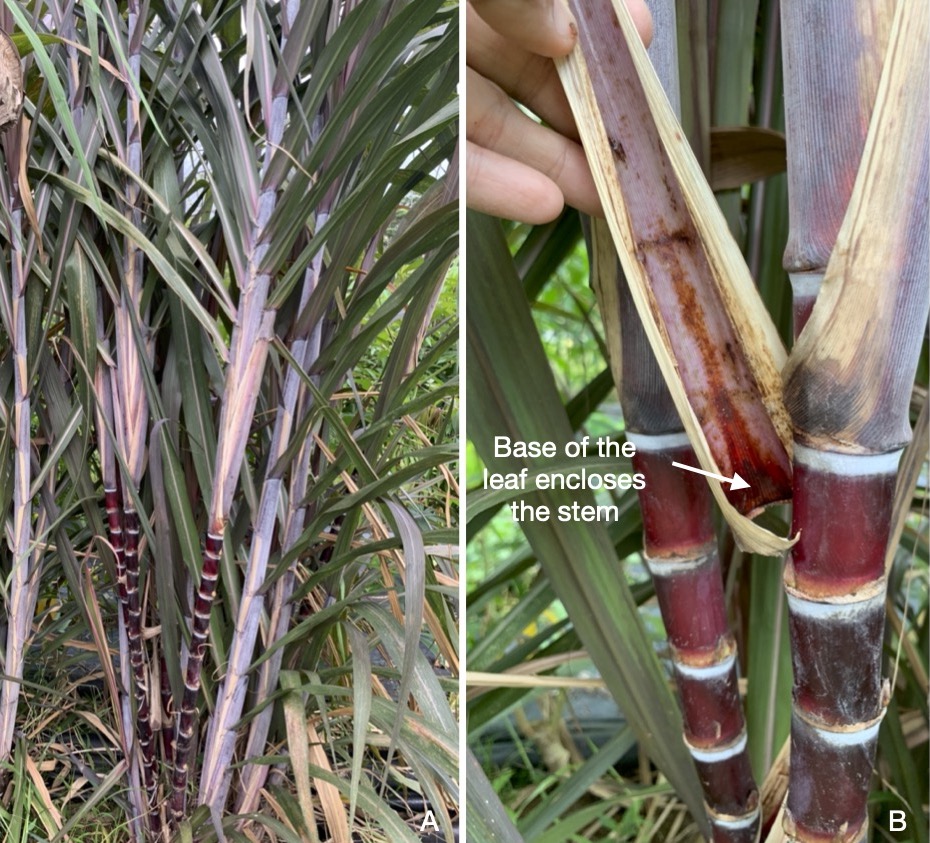
Common Characteristics
Habit: Herbs.
Flowers: Small and normally wind-pollinated. Flowers are formed into a spikelet which is composed of many different parts (glume and lemma).
Fruits and Seeds: The fruit is a caryopsis (Figure \(\PageIndex{4}\)) and the seed has one cotyledon as in other monocots.
Leaves: The leaves are normally alternate and have parallel veins. The base of the leaf encloses the stem of the plant creating a “leaf-sheath” while the top of the leaf (the blade) is detached from the stem (Figure \(\PageIndex{3}\)).
Stems: The stems are hollow except at the nodes.
Arecaceae
The Arecaceae or palm family has 2,600 species (Christenhusz and Byng, 2016). This family is known for its tree-like species (palm trees) which inhabit tropical and subtropical areas. Even though palms are monocots, which do not develop wood, the stems of these species are extremely strong. They are used to make furniture and musical instruments. The species are also used for food (e.g. coconut, palm sugar, and heart of palm), thatching, as well as hand crafts such as baskets and hats. Many palm species have edible fruits that are consumed in different locations. For example, dates (Phoenix dactylifera) are grown in dry areas and are part of the cuisine in the Middle East, North Africa, and certain parts of Asia. Açaí palm (Euterpe oleracea) is cultivated in the Amazon and its fruit is used to make very nutritious and savory meals. It has been a staple part of the diet of local habitants for centuries. Recently, açaí became a health food trend around the world and it is now eaten as a sweet treat.
Hawai‘i has an incredible diversity of native palms, with 22 endemic species of loulu (Pritchardia spp.; Figure \(\PageIndex{5}\)). Most species are native to specific islands or even specific mountain ranges on an island. The large leaves of these species were used to thatch roofs and make baskets and other items. The trunks were used for construction. The immature fruit (a drupe) was used as food (Hodel, 2012). Many loulu species are currently threatened or listed as endangered due to damage from invasive animals, such as pigs and rats. Rats eat the fruits, impacting the ability of the population to regenerate. In some areas you can find old trees, but no young plants or seedlings. This happens when rats remove all the viable seeds making it impossible for new seedlings to establish. Eventually, the old trees die and the population disappears from the wild. Pigs damage the bark and root systems as well, negatively impacting older plants in the populations.

The coconut palm (Cocos nucifera) is very important in many cultures. The fruit can be used as food and for coconut milk, the fiber can be used for cordage, and the leaves for handcrafts. The oil is important for many African (including the diaspora in the Americas) and Pacific Island cultures. Coconut oil has recently begun being used worldwide due to its nutritional benefits. Polynesians introduced coconut (niu) to Hawai‘i and this plant has been used for the purposes described above. This plant is considered one of the most versatile plants since every part of the plant has a use (Figure \(\PageIndex{6}\)).
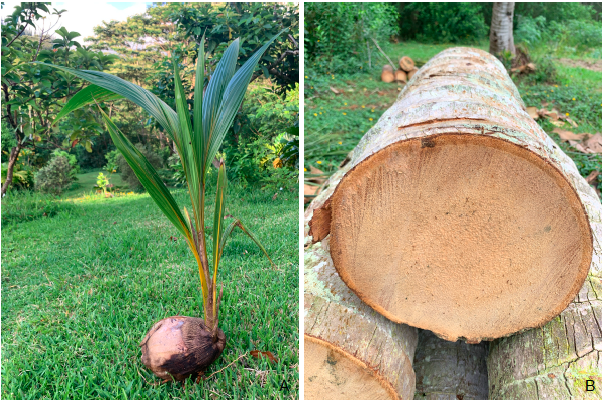
Common Characteristics
Habit: Lianas (climbers) and tree-like (palms).
Flowers: Small and symmetrical with three petals and three sepals. The flowers are arranged in an inflorescence (a cluster of flowers originating from a main branch).
Fruits and Seeds: Drupe with a single seed inside (sometimes two).
Leaves: Leaves are large and either palmately compound or pinnately compound.
Stems: Most common species have a single dominant stem that does not branch. Although some species grow in clusters. Like in other monocots, the stems do not produce wood (secondary growth).
Examples of Eudicot families
Fabaceae
The Fabaceae, also known as the bean or legume family, is a very important plant family with approximately 19,500 species. Many members of this family can grow in soils with low nutrient levels because they can form root nodules and house nitrogen-fixing bacteria, making them an important crop in areas with poor soil. Fabaceae are also known for being very rich in protein, which makes it a staple food in many diets. Plants in this family are important for human food (beans, lentils, peas, beans, soybeans), cattle forage (e.g. Leucaena), and as cover crops (species that are planted to enhance soil health on a farm). Several species in this family are known for their hardwoods, making them important as a source of lumber.
There are several native species in this family in Hawai‘i (Figure \(\PageIndex{7}\)). These include koa (Acacia koa; Figure \(\PageIndex{8}\)), wiliwili (Erythrina sandwicensis) and māmane (Sophora chrysophylla; Figure \(\PageIndex{7}\)). The wood of koa is highly valued and it is used to make furniture, jewelry, and art. The wood of māmane was used for house posts, fences, and digging sticks (o‘o), and the seed is used for lei making (Figure \(\PageIndex{9}\)). On Mauna Kea, the palila bird (Loxioides balleui) depends on the seeds of this plant as a food source, and the plants as nesting and roosting habitat. In ancient times, Native Hawaiians used wiliwili to make surfboards because its wood is buoyant. The beautifully colored seeds are used in lei making (Figure \(\PageIndex{10}\)).
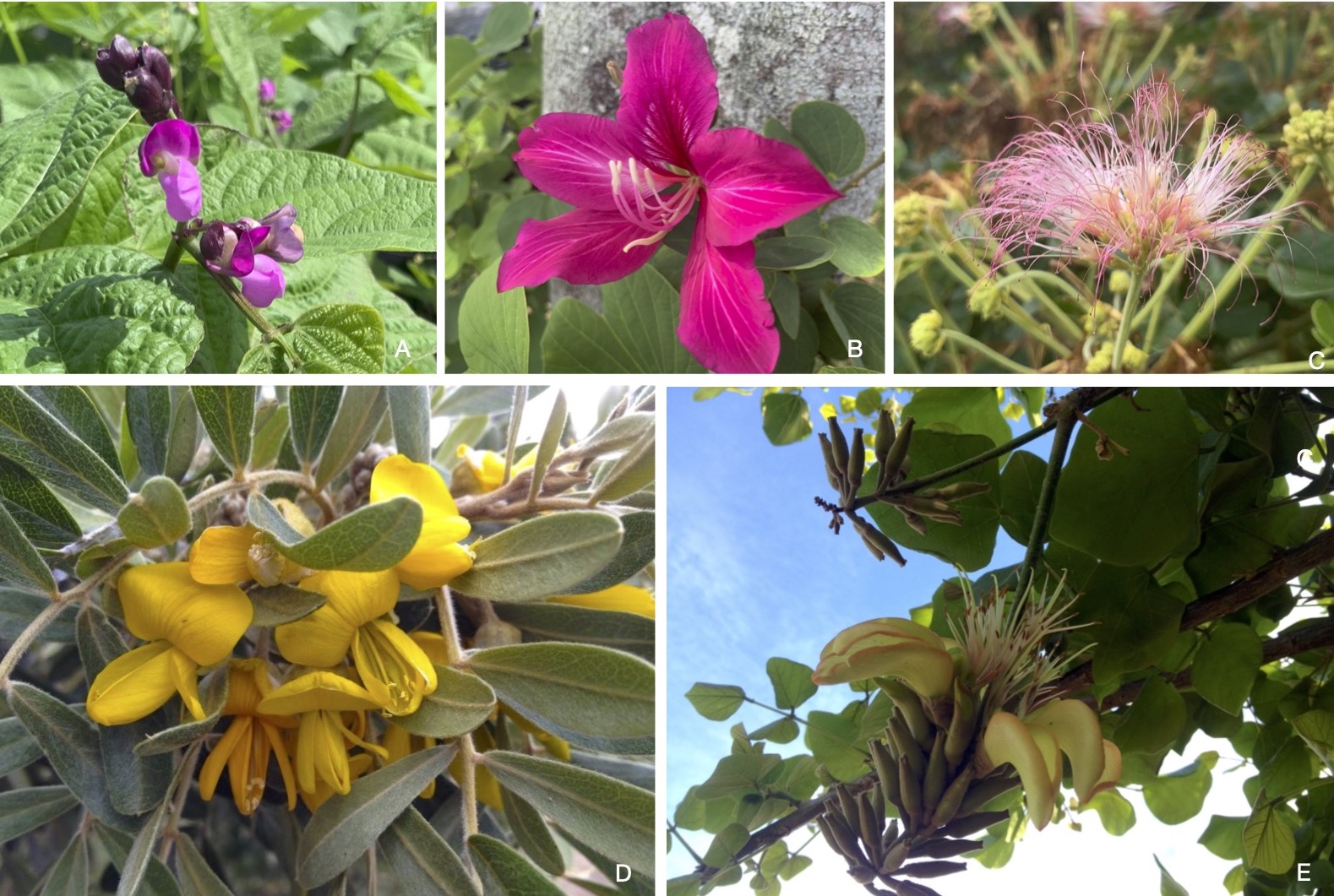
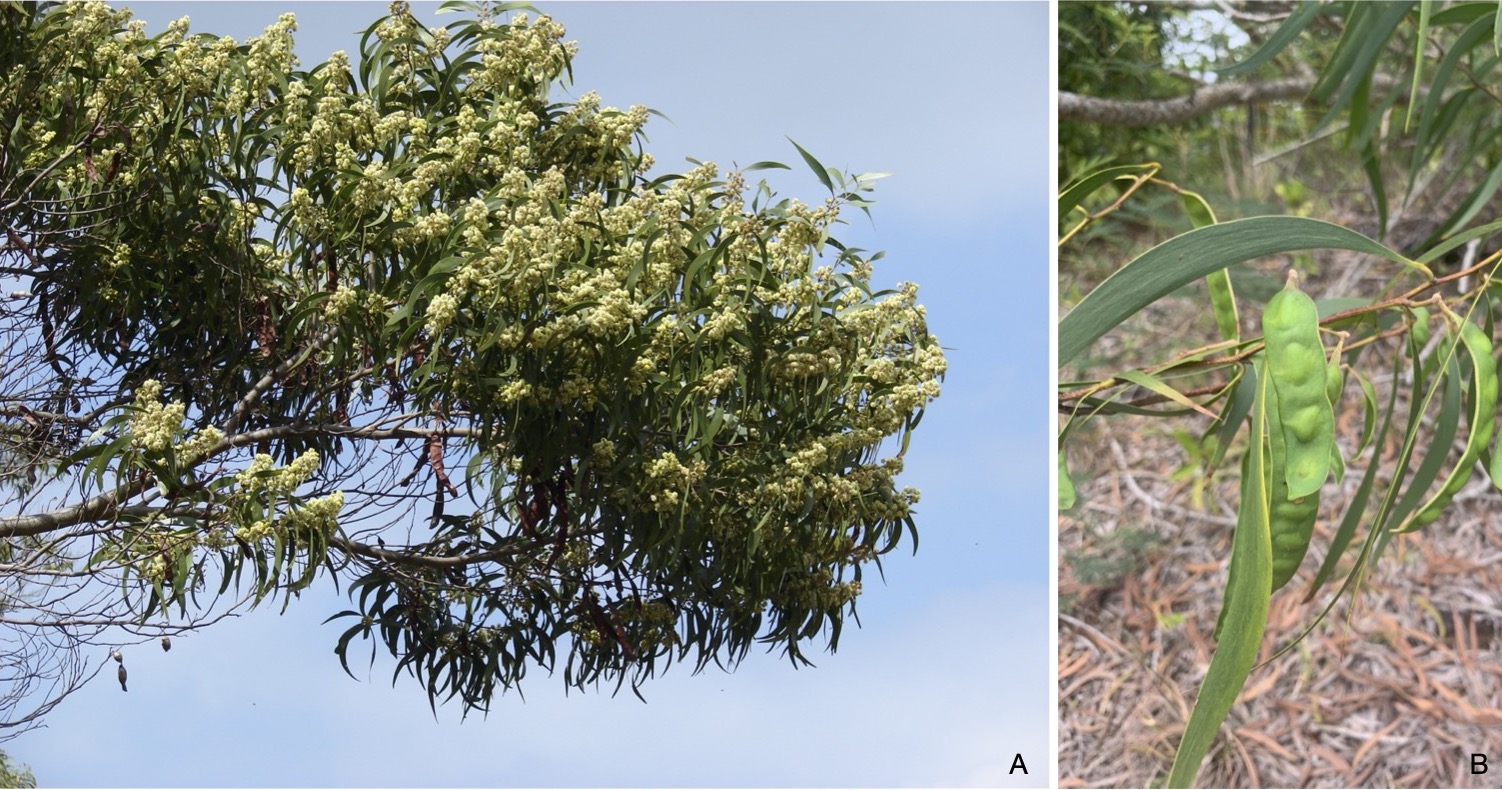


Common Characteristics
Habit: Herbs, shrubs, trees, vines and lianas.
Flower: Flowers are very diverse, varying among the six subfamilies in this family. Three of the most common flower types can be seen in Figure 14. Pea-shaped flowers are in the subfamily Faboideae. Flowers with multiple stamens and very small petals (as in monkey pod; Figure 14) can be found in the Caesalpinioideae subfamily. From afar they may look like puff balls. Flowers of the orchid tree (Bauhinia variegata) are large and colorful with five petals and are in the Cercicoideae subfamily.
Fruits and Seeds: Most fruits are legumes or loments. The seed is bean-like.
Leaves: Alternate and entire. Compound.
Stems: Stems can be herbaceous or woody.
Other: Nodules on roots contain nitrogen-fixing bacteria.
Solanaceae
The Solanaceae is also known as the nightshade family and it has about 2,600 species (Christenhusz and Byng, 2016). Many species are poisonous, while others have medicinal and ornamental uses. For example, belladonna/deadly nightshade (Atropa belladonna) is very toxic and causes hallucinations if ingested, as it contains several alkaloids. An ornamental plant that is commonly seen in Hawai‘i and that is extremely poisonous is the angel’s trumpets (Brugmansia sp.). This plant is used as a psychoactive drink in rituals in some cultures in South America and causes hallucinations. It was introduced to Hawai‘i in the 1800s from South America and can be seen growing in gardens. Tobacco (Nicotiana sp.) is also in this family. It can be highly addictive because it contains the alkaloid nicotine, which is a stimulant.
Many plants in this family are not toxic and are widely used for cooking. For example, many crop species such as potato tubers, tomatoes, peppers, and eggplants are used in cuisines all over the globe. Potatoes, tomatoes, and peppers are originally from the Americas, where they were first domesticated, and were introduced to the rest of the globe after European contact (Figure \(\PageIndex{11}\)). Tomatoes, for example, were first domesticated in Mexico and were introduced to Europe after the Spanish colonized the Americas in the 16th century. They are now an iconic component of several European cuisines. It is hard to imagine Italian food without the tomato, or even peppers, but it was only after Europeans brought those crops back from the Americas that they were introduced to Italy. The same thing is true about peppers anywhere in Asia. Thai food did not have hot chilies until they were introduced from the Americas.
Common Characteristics
Habit: Herbs, shrubs, trees, and vines.
Flowers: Flowers have five petals and five sepals. The stamens also occur in multiples of five and can fuse together around the pistil, forming a column (Figure \(\PageIndex{11}\)A).
Fruits and Seeds: Fruits are either berries or capsules.
Leaves: Frequently have prickles.
Stems: Stems are very diverse in this family due to different growth habits.
Other: Many species are poisonous and many are edible domesticated crops (e.g. tomato, pepper, eggplant, and potato).
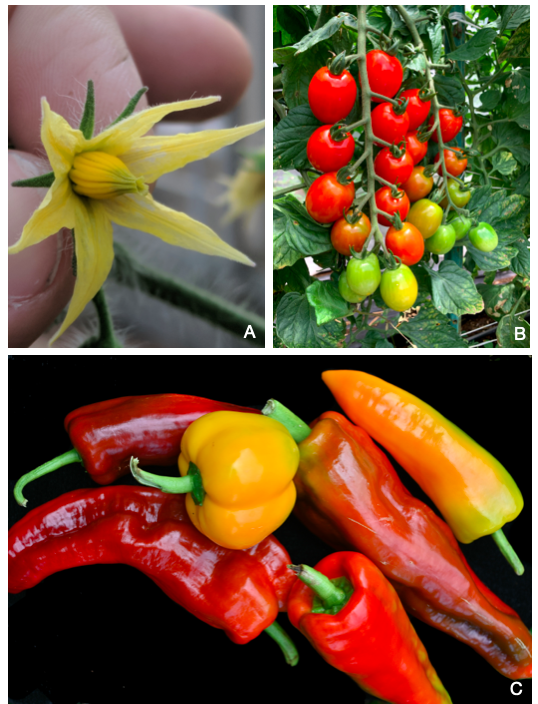
Asteraceae
The Asteraceae, also known as the sunflower family, has 24,700 species (Christenhusz and Byng, 2016). Species in this family can grow in a wide range of environments, but they most commonly occur in dry areas and deserts, including high-elevation zones. In Hawai‘i, for example, āhinahina or silversword (Argyroxiphium sandwicense subsp. macrocephalum) grows near the summit of Haleakalā at approximately 3,000 meters (10,000 feet) in elevation. The plant has leaves with furry hairs (trichomes) to protect the plant against sun and wind (Figure \(\PageIndex{12}\)).

This family has many economically important species that are used to make oil (e.g. sunflower), teas, and medicine (e.g. chamomile, echinacea). Several species are used for food: lettuce (Lactuca sativa), artichoke (Cynara cardunculus var. scolymus), and sunflower (Helianthus annuus). There are many ornamental species and cultivars in this family including marigolds (Tagetes spp.), chrysanthemum (Chrysanthemum spp.), zinnia (Zinnia spp.), and dahlia (Dahlia spp.), which are very important to the horticultural industry.
Asteraceae have very characteristic flowers. They are grouped into clusters called heads or capitulum, which are made up of dozens and sometimes hundreds of individual small flowers (Figure \(\PageIndex{13}\)). There are two main types of flowers composing the head. Ray flowers are on the outside of the heads with the petals on the very outside. Disk flowers, on the other hand, are in the inner part of the head. This arrangement likely evolved to attract pollinators.
Common Characteristics
Habit: Mostly herbs, but also shrubs and trees.
Flower: The inflorescences (cluster of flowers) are showy and the numerous flowers are packed in heads. A single flower can fall into one of three different types: disk florets, ray florets, and ligulate florets (Figure \(\PageIndex{13}\)).
Fruit and Seeds: Achene.
Leaves: Leaves can be arranged differently on the stems depending on the species (opposite, alternate or whorled).
Stems: The stems are most often herbaceous.
.jpg?revision=1&size=bestfit&width=642&height=660)
Myrtaceae
This family has many important edible species in Hawai‘i such as guava, strawberry guava, and mountain apple/‘ohi‘a ‘ai (Figure \(\PageIndex{14}\)). Today, 5,950 species exist worldwide in this family. The petals on the flowers can be reduced and the stamens numerous, giving the flower a fluffy appearance (Figure \(\PageIndex{14}\)). Some species in the family are important sources of timber (e.g. Eucalyptus spp.). Some species in this family produce essential oils (e.g. allspice; Pimenta dioica). One of the most important native forest species in Hawai‘i is ōhiʻa, Metrosideros polymorpha, which belongs to this family (Figure \(\PageIndex{14}\)D). Native birds depend on their flowers for nectar, they play an important role as watershed forests and are also highly important culturally.

Common Characteristics
Habit: Woody trees and shrubs.
Flowers: Flowers have five petals but they are often reduced, with numerous colorful stamens present (Figure \(\PageIndex{14}\)D).
Fruits and Seeds: Fruits are capsules or berries.
Leaves: Essential oils are present in the leaves of some species.
Stems: Stems are woody.


